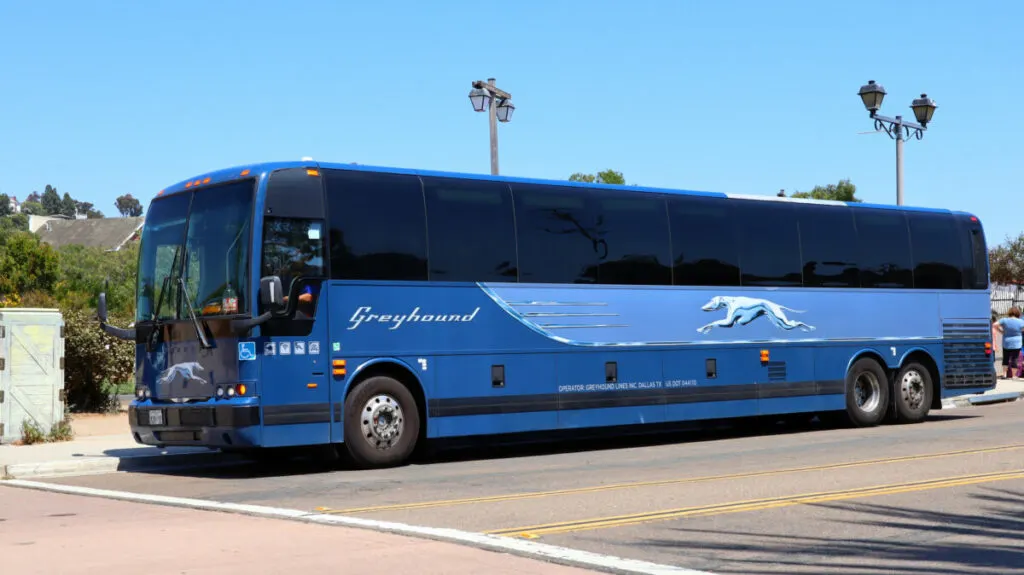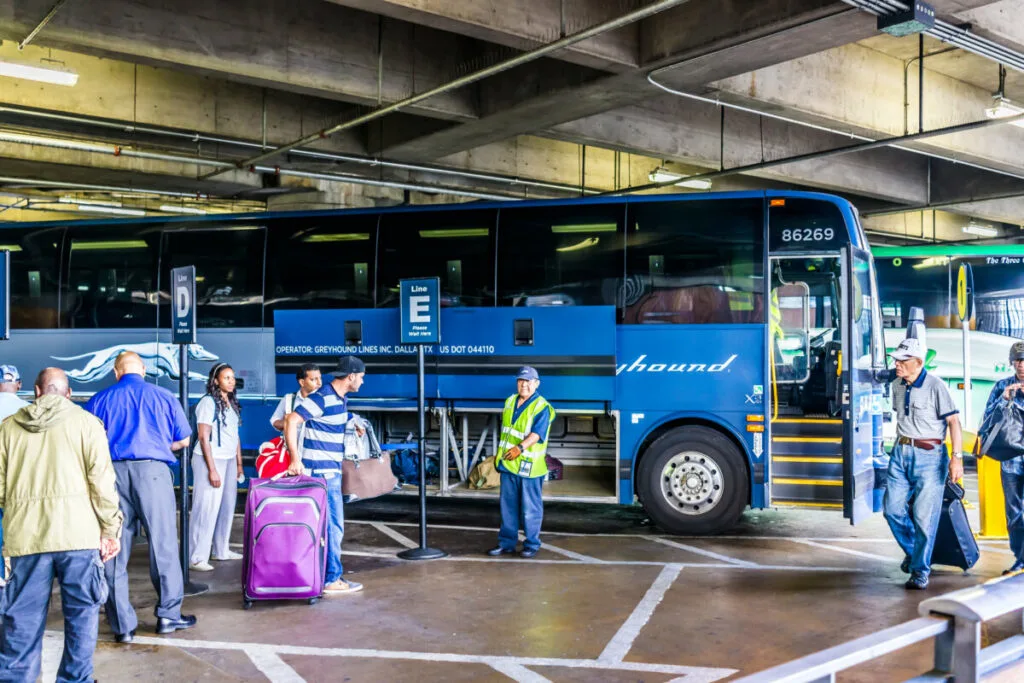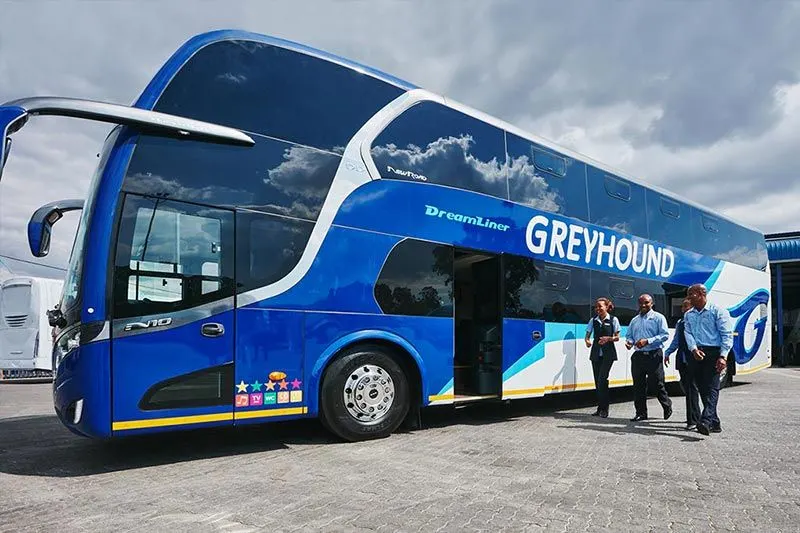Traveling by bus is not a novel concept but a well-tested and proven one. Among the numerous bus operators is the long-standing and respected Greyhound Lines Inc., known commonly as Greyhound. You might be curious about its safety profile as a traveler or prospective client.
Table of Contents
A Brief Overview of Greyhound Bus And Its Safety Reputation

In the United States, Greyhound is synonymous with long-distance bus travel. The company has been successfully operating for more than a century. Over this extended period, it has cultivated a reputation as a dependable service provider stretching across the nation, offering expansive coverage to small towns and big cities.
Greyhound’s safety record is underpinned by its two-pronged safety approach, which comprises its maintenance protocols and hiring procedures. The company’s fleet of buses undergoes regular and detailed inspections and maintenance work in line with industry standards. This ensures that every bus is in optimal running condition, reducing the risk of accidents due to mechanical issues.
Equally vital is the company’s commitment to recruiting and training competent drivers. Greyhound drivers have to meet strict standards. They need at least three years of driving experience before being considered for employment. Once hired, they undergo an intensive driving course, including simulator training.
Greyhound experiences incidents like any other transport service. It’s important to read reviews and do your research. In doing so, you might find cases of luggage theft or other minor annoyances.
Traveling in a Greyhound bus also involves reasonable measures that passengers themselves should take, like avoiding late-night travel routes and securing personal belongings. Greyhound cannot fully control these variables, and passengers play a role in mitigating them.
| Aspect | Safety Features |
|---|---|
| Maintenance and Inspection | Regular, detailed inspections and maintenance to ensure each bus is in optimal running condition. This reduces the risk of accidents due to mechanical issues. |
| Hiring and Training of Drivers | Stringent recruitment standards, including a minimum of three years of driving experience. Intensive training, including simulator training, for all new hires. |
| Passenger Self-Measures | Reasonable safety measures that passengers should take, such as securing personal belongings and choosing safer travel times, can enhance overall safety. |
So, while Greyhound takes all necessary precautions to ensure the safety of its passengers, remember, safety is also everyone’s responsibility.
See Related: Prayers for Travel | For Safety, Health and Well-Being
Greyhound Safety Records

Greyhound Lines, Incorporated has been in operation for over a hundred years, and throughout this period, it has earned its spot as a premier provider of intercity bus transportation across North America. However, it’s common for potential patrons to ponder the safety of riding a Greyhound bus.
Examining The Safety Records of Greyhound Buses and Comparing Them To Other Public Transportation Options
To provide a comprehensive response, it’s essential to evaluate the company’s safety records in the wider context of public transportation safety.
Highlighted below are some of the pivotal points differentiating and grading Greyhound’s safety standards compared to other alternatives.
- Accident Rates: Based on the Bureau of Transportation Statistics report, buses account for only 0.4% of accidents causing fatalities, as against 96% for cars. Logic dictates that, by extension, Greyhound buses account for a minuscule percentage of those bus accidents.
- Safety Standards: Greyhound safety measures are top-notch. The company adheres to strict safety protocols comparable to the aviation industry. They conduct frequent inspections, employ proficiently trained drivers, and use state-of-the-art technology to maintain safe operations.
- Safety Regulations: As a significant operator in public transportation, Greyhound is federally regulated and must abide by safety regulations laid down by the Federal Motor Carrier Safety Administration (FMCSA).
- Security: Greyhound also prioritizes passenger security. Security measures comprise bag checks and random screenings at certain locations, reminiscent of practices observed at airports.
While it’s clear that riding with Greyhound is comparatively safer than several forms of transportation, it wouldn’t be fair to ignore isolated instances of accidents. This reality underscores why Greyhound continues to invest and prioritize safety measures across its operations.
In conclusion, although no form of travel is entirely risk-free, Greyhound has established a strong track record in terms of safety. Add their dedication to maintaining high safety standards and robust regulatory oversight, and you get an intercity bus service that stands as one of the safest means of public transportation.
| Criteria | Greyhound Safety |
|---|---|
| Accident Rates | Greyhound buses account for a minuscule percentage of bus accidents, making them relatively safe. |
| Safety Standards | Greyhound’s safety measures are stringent and comparable to the standards in the aviation industry. |
| Safety Regulations | Greyhound has to comply with federal safety regulations, enhancing its overall safety profile. |
| Security | With measures like bag checks and screenings, Greyhound’s security measures further ensure passenger safety. |
See Related: How to Book the Cheapest Greyhound Bus Ticket Prices
Common Safety Concerns

Many ponder their safety when thinking about boarding a Greyhound bus. After all, the media often reports every minor mishap with disproportionate attention. However, it’s essential to separate hype from reality and look at the facts to assess the safety of Greyhound buses accurately.
Addressing The Common Safety Concerns Associated With Greyhound Buses, Including Issues At Stations And On Board
Let’s dive into common concerns and their respective truths.
- Driver Quality: The major concern is the Greyhound drivers’ professionalism. Like many reputable businesses, Greyhound maintains an extensive training regime, ensuring its drivers are skilled and safety-conscious. They all must pass the Commercial Driver’s License (CDL) exam, mandatorily enforced by the FMCSA.
- Station Safety: Greyhound bus stations are rarely found in the poshest neighborhoods. However, trouble rarely materializes if travelers remain aware of their surroundings and belongings. Greyhound takes necessary measures to ensure that facilities are safe for passengers.
- On-board Safety: While occasional discomforts may happen due to co-passenger behavior, Greyhound has regulations that passengers must adhere to, ensuring a safe and comfortable trip for everyone. From restricting alcohol and drug use to enforcing a strict carry-on bag policy, Greyhound continually strives to provide a safe travel environment.
- Vehicular Maintenance: A common concern may be related to the mechanical upkeep of buses. Greyhound emphasizes maintenance and safety checks, complying with FMCSA regulations. Regular inspections, pre-trip safety checks, and thorough maintenance tasks are part of their standard operations.
- Security Checks: To ensure passenger safety, Greyhound has implemented security measures akin to airline industry standards, including baggage-checking. Additionally, there has been an increase in security personnel at stations and on-board buses.
In essence, while travel, whether by air, car, or bus, comes with inherent risks, Greyhound takes actionable steps to maximize the safety of passengers.
Here’s a snapshot of the safety measures taken by Greyhound:
| Safety Concern | Greyhound Response |
|---|---|
| Driver Quality | Extensive training and CDL certification requirements |
| Station Safety | Increased security measures and vigilant staff |
| On-board Safety | Strictly observed passenger regulations |
| Vehicular Maintenance | Regular inspections and compliance with FMCSA regulations |
| Security Checks | Baggage checks and increased security personnel |
Greyhound has robust safety structures and procedures in place. They are committed to maintaining their long-standing reputation and trust built with passengers over many years. So, one may rest assured that a trip with Greyhound, while not devoid of potential discomforts, is fundamentally safe and secure.
See Related: The Ultimate Guide to Navigating the x27 Bus Schedule
Greyhound Safety Measures

Greyhound, the largest North American intercity bus company, certainly rings a bell regarding long-distance bus travel. With a vibrant history dating back to 1914, Greyhound is popular for their commitment to making every journey an experience worth taking.
Given the nature of their operation, the perennial question “is Greyhound safe?” often comes up. To put concerns to rest, Greyhound invests a lot in safety – all geared towards ensuring passengers reach their destination safely. If you’re worried about traveling with Greyhound, here’s an in-depth look into their safety measures.
Exploring The Safety Measures Implemented By Greyhound To Ensure Passenger Safety
Greyhound’s Safety Policies: Greyhound firmly adheres to the safety regulations laid out by the Federal Motor Carrier Safety Administration (FMCSA). They have numerous measures in place, including strict drug and alcohol policies, in-depth background checks of drivers, and rigorous driver training programs.
Driver Training: Greyhound bus drivers undergo a vigorous 6-week training program, making safety a top priority. This program emphasizes defensive driving, real-life situations, and customer service, preparing the drivers for various eventualities.
Maintenance: Greyhound buses are regularly inspected and maintained to optimal safety standards. Every bus is subjected to a systematic preventive maintenance program, and buses that do not meet safety standards are not dispatched to the roads.
On-board Safety: Onboard every Greyhound bus, you’ll find the latest safety features. This includes emergency exits, fire extinguishers, and an onboard restroom equipped with a smoke detector.
Baggage Safety: Greyhound has procedures to ensure no unattended bags or packages are allowed onto their buses. Their guidelines on baggage allow one carry-on and one checked-in bag per passenger, with size and weight restrictions.
Here’s a look at Greyhound’s safety aspects in a nutshell:
| Safety Aspects | Explanation |
|---|---|
| Greyhound’s Safety Policies | Greyhound strictly adheres to FMCSA regulations, implementing strict policy measures like drug and alcohol checks, background checks, and a rigorous driver training program. |
| Driver Training | Greyhound drivers undergo a 6-week training program focused on safety, emphasizing defensive driving and customer service. |
| Maintenance | Regular inspections and preventive maintenance programs ensure Greyhound buses are well-tuned and safe for the road. Buses that do not adhere to the safety standards are not put into operation. |
| On-board Safety | Every Greyhound bus comes equipped with emergency exits, fire extinguishers, and an onboard restroom with smoke detectors. |
| Baggage Safety | Every Greyhound bus has emergency exits, fire extinguishers, and an onboard restroom with smoke detectors. |
The multi-layered safety approach employed by Greyhound gives a much-needed assurance to every traveler. So, next time you board a Greyhound bus, rest comfortably, knowing that a multitude of safety measures are in place to ensure your safe journey.
See Related: How to Play Ride the Bus [Step-by-Step Guide]
Tips For a Safe Journey on Greyhound

For those embarking on a journey with Greyhound, ensuring the trip is as safe as possible is often the main concern. The good news is that Greyhound buses, like any other transportation, come with safety procedures and guidelines provided by dedicated staff and policies, ensuring passengers can travel confidently.
See Related: Best Bus Companies to Book Your Journey
Inspect The Surroundings
Keep your eyes open: The first step towards personal safety is being aware of your surroundings. Inspect the bus before boarding and notify the driver or bus station attendants if anything seems amiss.
Essentials At Hand
Keep your belongings close: Never leave valuables unattended. It’s also recommended to keep essential items such as your wallet, ID, phone, and tickets nearby. If there are overhead compartments or under-seat storage, use those and ensure they are locked.
Familiarize With Exits
Identify the exits: On boarding the bus, check where emergency exits are located. In the unlikely event of an emergency, having this knowledge is crucial to help you and others get off the bus swiftly and safely.
Trusting The Statistics
Understanding the odds: Statistically, bus travel tends to be safer than driving a personal vehicle. According to a 2013 study by the American Bus Association, there is only one injury for every 3 million passenger trips and one fatality for every 500 million passenger trips.
Stay Sober
Maintain sobriety: It’s wise not to imbibe alcohol before or during your trip. Alcohol not only dehydrates you but can also affect your awareness and judgment.
Here’s a summary of safety tips for your Greyhound journey:
| Safety Tip | Reason |
|---|---|
| Inspect surroundings | Being aware of your surroundings can help you stay safe |
| Keep valuables close | Prevents loss and theft |
| Identify exits | Alcohol can affect awareness and judgment |
| Understand transportation statistics | Helps maintain perspective on the relative safety of bus travel |
| Maintain sobriety | Alcohol can affect awareness and judgement |
As long as these safety guidelines are adhered to, anyone can enjoy a smooth ride on the Greyhound buses. Always remember personal safety is a shared responsibility, and every passenger plays a role in ensuring a secure environment. Happy travels!
See Related: Plan Your Commute: A Guide to the 545 Bus Schedule
Final Thoughts: Is Greyhound Safe to Ride?
Embarking on a journey by bus, particularly over long distances, often brings safety-related questions to mind. Regarding popular bus services, Greyhound has been a notable player, connecting various cities across North America. In this context, it is natural that potential passengers inquire about the safety measures Greyhound implements.
So, is Greyhound safe? In the grand scheme of things, statistics show that bus travel, in general, is much safer compared to driving. The National Safety Council report indicates that car accidents happen 63 times more often in the United States than in bus accidents. As a responsible service provider, Greyhound takes various preventive measures to ensure passengers’ safety.
Quality Maintenance: Firstly, Greyhound buses undergo regular maintenance checks and routine inspections. Each vehicle goes through preventative maintenance from its renowned gigantic fleet to guarantee passengers’ well-being and comfortable experience.
Professional Drivers: Greyhound takes professionalism to heart regarding their drivers. All drivers must have a commercial driver’s license (CDL) and undergo extensive training. It does not only end at prepping them to navigate the route and handle the bus; it also covers emergency procedures and safety guidelines.
Evolved Safety Measures: Greyhound does not neglect evolving security trends. For instance, most of their buses have a drive cam that helps monitor drivers for risky behavior and improve their performance over time.
24/7 Assistance and Planning: Added to the aforementioned, Greyhound provides around-the-clock roadside assistance. In case of vehicle breakdowns or issues, help is only a phone call away. Route planning is also done meticulously to ensure maximum safety on the journey, reducing the risk of accidents due to haste or strain.
Sure, there could be unforeseen circumstances, such as unruly passengers or changes in weather, which may instigate concerns. But even in such cases, Greyhound staff are trained to manage and navigate situations, maintaining the safety of passengers as their utmost priority.
Here’s a snapshot of the considerations towards safety measures at Greyhound:
| Safety Measures | Insight |
|---|---|
| Quality Maintenance | Regular maintenance checks and inspections are performed on Greyhound buses. |
| Professional Drivers | Round-the-clock roadside assistance is available, and routes carefully planned to reduce the risk of accidents. |
| Evolved Safety Measures | Greyhound buses are fitted with drive cams to monitor and improve driver performance. |
| 24/7 Assistance and Planning | Round-the-clock roadside assistance is available and routes are planned carefully to reduce the risk of accidents. |
When boarding a Greyhound bus, one can be reassured of a journey emphasizing safety as a core priority.
Related Resources:
